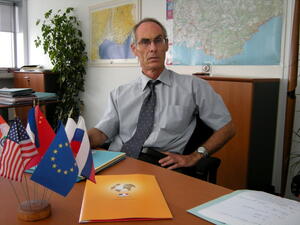A man with a mission
ITER is a house with many mansions. The ITER Organization, the seven Domestic Agencies, Agence Iter-France, Mission ITER; each and every one of them plays a key part in the development of the project. Mission ITER is one of these mansions. It is a small structure that is an essential player in the ITER venture. "We represent the French state at the regional level," says Colin Miège, Mission ITER Director. "We were established to create the best conditions for welcoming the project and make sure that France's commitments to ITER are implemented locally."
The ITER Itinerary and the International School in Manosque are the most visible of these commitments. The Itinerary, by now "95 percent completed," will be delivered in the early weeks of 2010 and at the International School, the first half of the buildings will open by mid-September—only two weeks late despite months of difficult weather last winter and spring.
One of the less visible aspects of Mission ITER's action is to organize coherent responses to ITER's demands and challenges, both on the economic and political levels. This means, among other things, supporting and mobilizing French companies to help them position themselves for calls for tender issued by the ITER Organization and the European Domestic Agency.
In addition to the French state financial contribution to ITER, local governments have pledged more than EUR 460 million to the project—the equivalent of a full-fledged Member's contribution. They rightfully expect some return on their investment.
"ITER has given a strong momentum to the local economy," says Colin Miège. "In two years, ITER-related works have generated contracts for more than EUR 360 million; 80 percent of these contracts were awarded to companies based in the Provence-Alpes-Côte-d'Azur region. The economic benefits are obvious when you look at these figures."
But the local impact of the ITER project goes far beyond contracts and jobs. "ITER presents this region with a unique development opportunity. But we, on the local side, have to be organized in order to make the most out of it. It's a big challenge—we have to federate some 18 different local authorities whose territories overlap and whose interests may differ at times. It all boils down to this: we must talk with one voice. We're dealing with a new kind of 'territorial governance' in a newly defined territory and that is far from easy."


